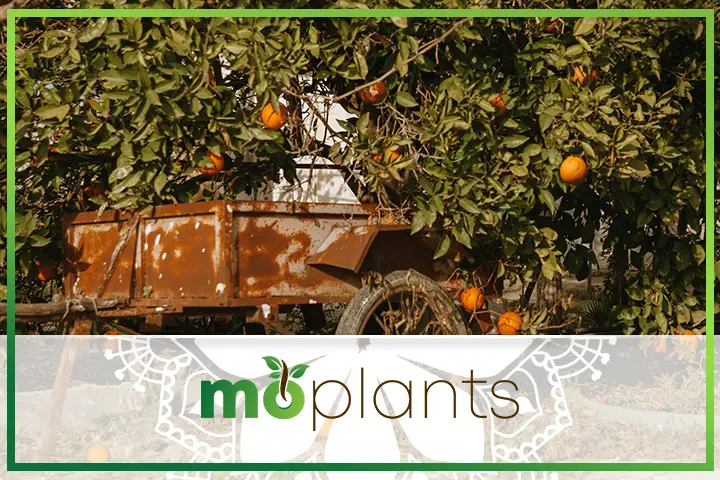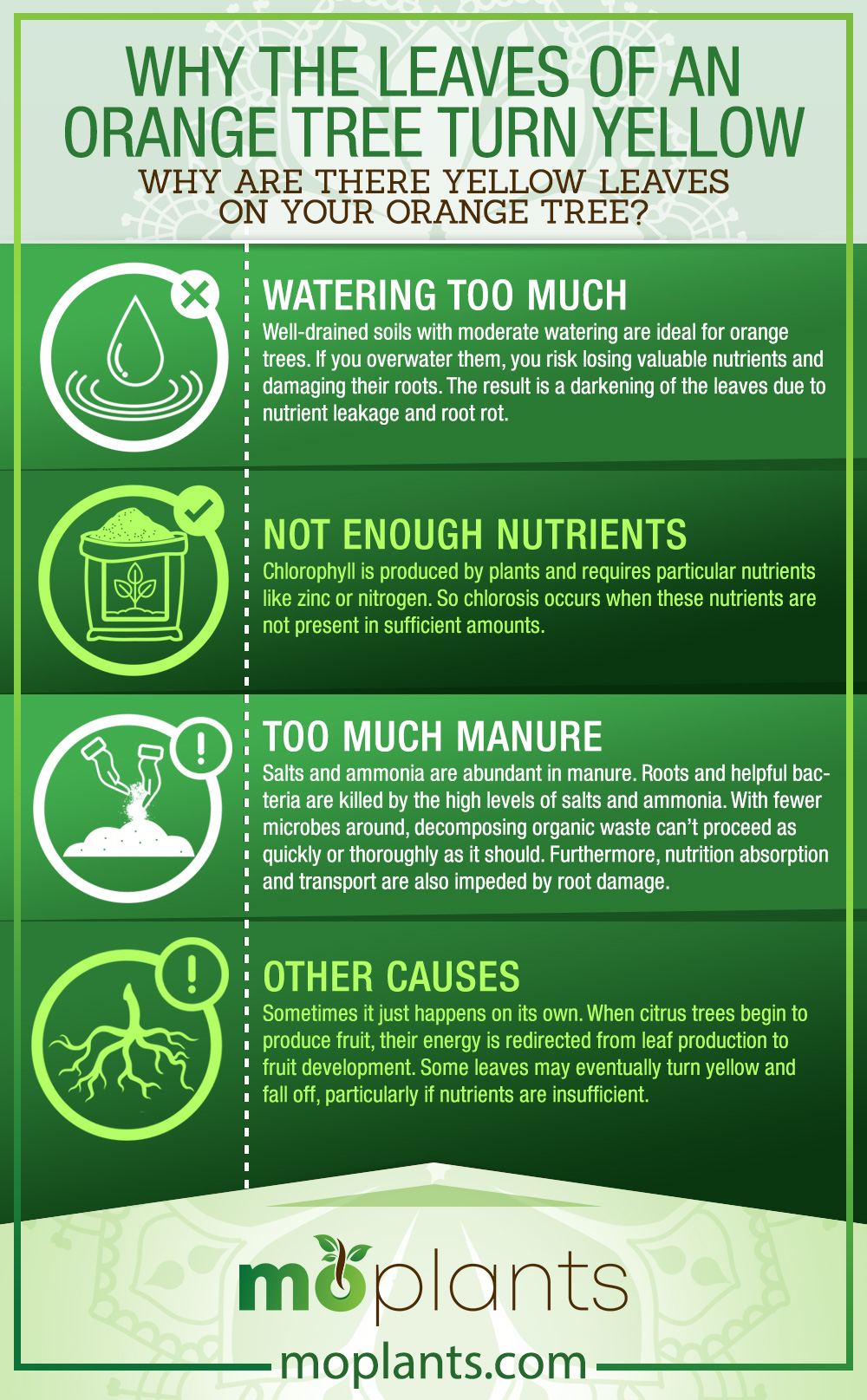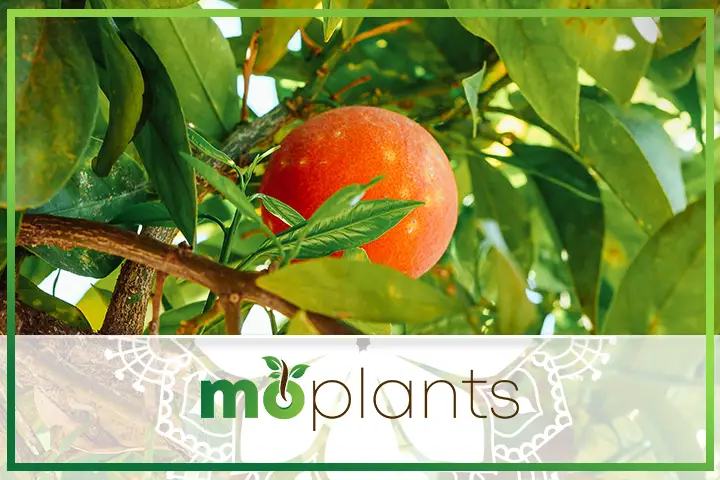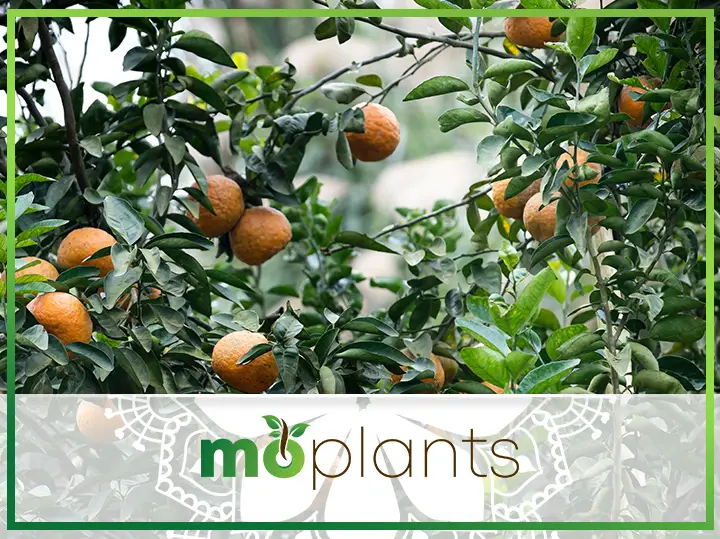Chlorosis, or the yellowing of foliage, is another name for this condition. Lack of chlorophyll causes leaves to become yellow. When grown in less than ideal circumstances, orange trees sometimes have fading leaves. So, why do orange tree leaves become brown?
Even though you may be silently yelling this to yourself as you see an orange tree’s health decline, there are several potential causes for yellowing orange tree leaves, many of which are manageable.
Why Are There Yellow Leaves On Your Orange Tree?
Overwatering, insufficient nutrients, an abundance of organic waste, and ailments like root rot are the most common causes of leaf yellowing in orange trees. The inability of a plant to absorb water and minerals and transfer them effectively is a common result of leaf discoloration.
Watering Too Much
Well-drained soils with moderate watering are ideal for orange trees. If you overwater them, you risk losing valuable nutrients and damaging their roots. The result is a darkening of the leaves due to nutrient leakage and root rot.
Nutrient deficiencies may occur momentarily due to leaching below the rooting zone. A transient impact still causes the leaves to become yellow and die off too soon. The leachable nutrients are too deep for the plant roots to reach. Nevertheless, when the roots expand, they are able to reuse the nutrients that were previously lost.
Infectious root rot may ruin otherwise robust plant roots. Because of decay, the very few healthy roots can’t take up as many nutrients and can’t get those nutrients to the rest of the plant. Due to a lack of nutrient supply, chlorophyll production in the leaves is stunted when just a few roots are healthy. If your tree is in the center of the grass, you should move the sprinklers so that they don’t water the trunk, and instead use a drip line to water the tree slowly over the course of many hours or even overnight (depending on its age).

Not Enough Nutrients
Chlorophyll is produced by plants and requires particular nutrients like zinc or nitrogen. So chlorosis occurs when these nutrients are not present in sufficient amounts. There are two main causes of chlorosis due to nutritional deficiencies, and they are:
Disease caused by: an excess of iron chloride or chlorosis of nitrogen
Due to its inaccessibility to the orange trees in solid form, iron becomes inadequate in soils with a pH over 7.0, excessive phosphate, as well as the presence of lime. A plastic-like coating is formed by solid iron, reducing soil aeration and leading to waterlogging. Since iron is a stationary nutrient, a lack of it stunts the expansion of leaves only during their early stages of development.
A chlorotic environment stunts development, diminishes fruit size and lowers yields. When seeing the first indications of chlorosis, you should take action to treat it so that your citrus trees don’t suffer long-term consequences like dropping fruit and leaves. As an alternative, you might take preventative steps to ensure that your leaves don’t turn yellow.
If your orange trees turn yellow, it may be because of a lack of nitrogen. Yellowing, known as nitrogen chlorosis, is a typical side effect of providing the tree with just a diet rich in carbon-based organic materials.
Soil microbes take up available nitrogen by decomposing organic matter, which can therefore no longer support plant growth. Nitrogen may be transferred from more mature leaves to their younger counterparts as a mobile nutrient. Thus, nitrogen chlorosis progresses from more mature leaves to tender shoots. Discoloration of leaves may also be caused by a deficiency of magnesium and zinc in the soil. Both magnesium and zinc are mostly stationary in the body. Young and middle-aged leaf growth is first affected by manganese and zinc deficiencies.

Too Much Manure
Salts and ammonia are abundant in manure. Roots and helpful bacteria are killed by the high levels of salts and ammonia. With fewer microbes around, decomposing organic waste can’t proceed as quickly or thoroughly as it should. Furthermore, nutrition absorption and transport are also impeded by root damage. When this happens, chlorosis sets in because there aren’t enough nutrients to make chlorophyll.
Other Causes
Sometimes it just happens on its own. When citrus trees begin to produce fruit, their energy is redirected from leaf production to fruit development. Some leaves may eventually turn yellow and fall off, particularly if nutrients are insufficient.
Other times, there are more serious causes. Fungal disease and Chlorosis are the most common causes of orange leaves becoming yellow (CVC). Root rot, also known as Phytophthora gummosis, is often caused by fungi or excessive irrigation.
The rotting of otherwise healthy roots directly results from root rot, which in turn reduces the plant’s ability to take up nutrients. Because CVC persists in the xylem, it interferes with the structure and function of this tissue. This means that CVC restricts the movement of water and nutrients to other plant organs.
Infographic

How Can You Stop the Orange Tree Leaves Turning Yellow?
The leaves yellowing on orange trees may be remedied. Despite orange trees’ increased longevity, chlorosis cannot be cured indefinitely. Therefore, treatment methods need to be reapplied after a particular period of time in order to provide optimal effects.
Learn why your orange tree’s leaves are turning yellow and how to prevent it.
Make Sure Growing Conditions Are Favorable
Even plants, like mammals, may experience shock if their normal environment suddenly changes significantly. This is common when the tree has been transplanted or subjected to extreme weather. The leaves of orange trees may droop as a result of this.
Managing The Weather Conditions
When there is a drastic shift in the climate or temperature, it may cause stress in orange trees. This usually refers to weather that is either abnormally cold or hot. Of course, this is something to keep an eye out for around the summer solstice and winter solstice since these are the times when the seasons shift.
Extreme heat (above 90 degrees) or cold (below 32 degrees) may be harmful to orange trees. Protect orange trees from heat and frost by shading them in the afternoon (whenever the sun is at its peak) and covering them at night.
A planted orange tree may be brought indoors, but the temperature change should not be too drastic.
Move The Plant Carefully
A further prevalent cause of stress in orange trees, shown by yellowing leaves, is transplant shock. Naturally, this happens after the tree has been planted or repotted.
Transplant shock is virtually inevitable when a tree is dug up and replanted, but there are techniques to mitigate its negative consequences and stress.
How to quickly lessen the effects of transplant shock:
- Don’t mess with the root ball
- Keep the taproot whole if the plant has one.
- Verify if the fresh dirt is crumbly and aerated. Make sure it’s not dead or collapsed.
- Lightly compact the dirt after planting.
- Spray heavily after planting.
Citrus Fertilizer Treatment
This remedy is a gradual method of restoring the green color to orange trees’ yellowing leaves. Therefore, fertilizers high in nitrogen or sulfur should be used to cure moderate chlorosis. For trees with severe chlorosis, this approach is ineffective. Two methods for fertilizing soil are described below:
- Addition of fertilizer high in nitrogen and sulfur.
- Incorporating ferrous chelates into the ground.
- The application of fertilizer to soil is simple. The fertilizer or iron chelates should be worked into the dirt. Check to see that it doesn’t go deeper than two inches into the earth. When it rains, or you water it, the fertilizer dissolves into the ground.
Foliar Spray Treatment
Nutrients that can be dissolved in water are used in this kind of treatment. This therapy strategy only takes a few sessions to implement, yet it yields positive effects. Foliar treatments should be applied every 60–90 days for optimal effects. Iron chlorosis is more effectively treated with this strategy. The steps for applying foliar spray are as follows:
A solution of 1 pound of sulfate or chelates per /20 gallons of water is recommended. Flour made from soybeans should be added to the mix. This will aid the solution’s adhesion to the leaves.
You may help moisten the leaves by adding a tablespoon of detergent. To apply the liquid to the leaves, use a pump-style sprayer. Structures and other surfaces should be spared the solution’s corrosive spray. You should spray the solution at night or when it’s chilly outside. This will ensure that the leaves have plenty of time to take it up.
Trunk Injection
This involves injecting chlorotic plants with iron or manganese-rich chemicals. Even though it is a pricey therapy that works quickly it can be used for up to three years.
Instructions for administering a trunk injection:
- Make your incisions in the lower trunk or root flares where they meet the ground.
- Put iron citrate or a substance high in manganese via the openings in the trunk.
It is recommended that trunk injections be performed in the spring. However, you may apply at any time of year if the leaves exhibit indications of chlorosis. To infuse the trunk, hire an arborist. All this is done to cut down on possible injuries.
Make Sure pH Level Is Balanced
The soil’s pH is decreased, so the iron nutrients don’t get solid. Chlorosis may be treated irreversibly by reducing the soil pH. Deeper soils, however, are almost difficult to alter the pH of. Therefore, adding iron sulfates, iron chelates, or urea to the soil is a more practical method.

Additional Suggestions for Preventing Orange Trees’ Yellowing Leaves
- Spread a layer of compost, about 1 to 2 inches thick, on the soil’s surface to provide the orange tree access to a steady supply of high-quality nutrients throughout the year. It may be the only fertilizer you need.
- Spread a layer of mulch that is one to two inches thick (over the compost, if used). With time, the mulch will decompose into even more beneficial nutrients, and it will also aid in water retention and prevent soil degradation by blocking the sun. Because of this, you may reduce the frequency with which you water your orange tree.
- Every two weeks, at the very least, you inspect your orange tree for symptoms of pests and disease as well as changes in soil moisture. As a result, you’ll be able to maintain better checks just on trees and respond more swiftly if an emergency arises.
- Dog urine is strong in nitrogen and may (molecularly) burn the orange tree, so don’t allow your pups to do their business there. The leaves may become yellow due to an overabundance of nitrogen. It doesn’t take much pee to kill a young tree.
You can easily tell whether or not your orange tree is alive by either doing minor pruning or scratching the bark of a short limb. If there is still greenery inside, then the plant is alive. If it turns out to be dead, you may learn from the experience and apply the lessons you’ve learned to the plants that are still thriving. Even if it’s too late to use the treatment highlighted in this guide, you can always start again with seeds from your local nursery or online.

